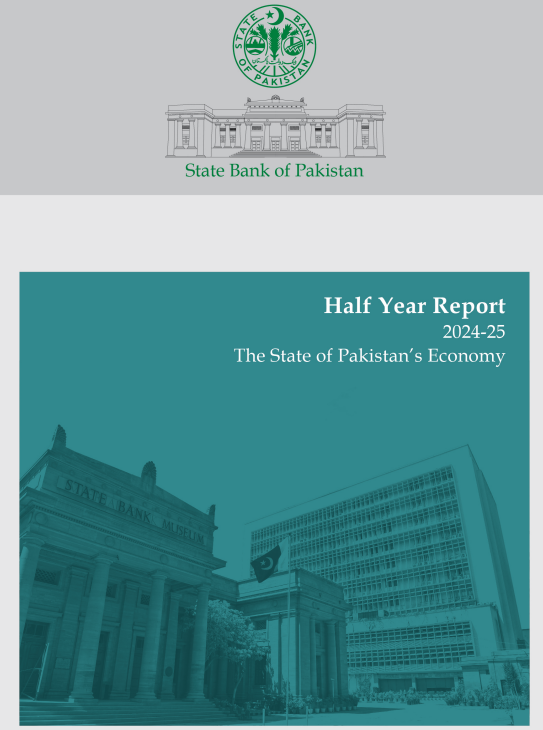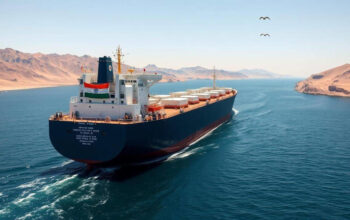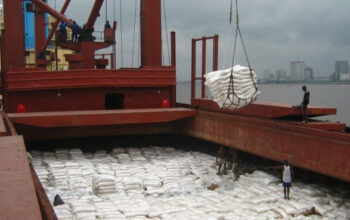By Staff Reporter
KARACHI: Pakistan’s economy showed marked improvement in the first half of fiscal year 2025, with inflation dropping to its lowest level in decades and the current account balance swinging into a surplus, the central bank said on Monday.
The State Bank of Pakistan (SBP) in its Half Year Report for FY25 said the headline inflation fell to 0.7% in March 2025, a multi-decade low, while the fiscal deficit was contained to its smallest size since FY05.
“Headline inflation fell sharply, reaching a multi-decade low of 0.7 percent by March 2025,” the SBP said, attributing the steep disinflation to a tight monetary policy stance, fiscal consolidation, improved supply conditions, stable energy prices, and benign global commodity prices.
The report credited these gains to a calibrated monetary policy, disciplined fiscal measures, and external support from the International Monetary Fund’s (IMF) Extended Fund Facility (EFF) program. “The calibrated monetary policy stance, fiscal consolidation, benign global commodity prices together with approval of IMF’s Extended Fund Facility program mainly underpinned these favorable outcomes,” the SBP noted. “The upgrade of Pakistan’s credit rating by international agencies further underscored growing confidence in the country’s economic management.”
Monetary Easing
With inflationary pressures easing, the SBP slashed its policy rate by a cumulative 1,000 basis points between June 2024 and February 2025, bringing relief to borrowers and signaling a shift toward stimulating economic activity. “The SBP reduced the policy rate by 1000 basis points from June 2024 – February 2025,” the report stated, linking the decision to “cooling inflationary pressures and improving inflation outlook.”
The rate cuts, combined with a slight uptick in economic activity and lending tied to the Agriculture Development Bank, spurred significant growth in private sector credit during the first half of FY25. This easing of financial conditions could bolster business confidence, though the impact on broader growth remains under scrutiny given persistent structural challenges.
External Sector
Pakistan’s external position also brightened, with the current account balance recording a surplus in H1-FY25—a rare achievement for an economy historically plagued by deficits. “A steady increase in exports and workers’ remittances during H1-FY25 outweighed a notable increase in imports, leading to a surplus in the current account balance,” the report said.
Exports of textiles and agricultural goods, alongside robust remittance inflows from overseas Pakistani workers, offset a rise in imports driven by recovering domestic demand. The disbursement of the first tranche under the IMF’s EFF program, coupled with a modest increase in private inflows, further bolstered the SBP’s foreign exchange reserves, providing a buffer against external shocks.
Growth Moderates
Despite these gains, real GDP growth moderated in H1-FY25, hampered by lower agricultural output and a contraction in industrial activity. “The moderation in real GDP growth was attributed to lower production of important kharif crops and contraction in industrial activity during H1-FY25,” the SBP said.
The agriculture sector suffered from a broad-based decline in kharif crops, such as rice and cotton, due to falling cultivation areas and reduced yields. The report pointed to a mix of factors: “agriculture policy uncertainty, last year’s low crop prices, unfavorable weather conditions, and lower use of certified seeds and other inputs” as key culprits.
Industry, meanwhile, saw a less severe contraction than the previous year, supported by small-scale manufacturing, utilities, and slaughtering. However, mining and quarrying, construction, and large-scale manufacturing remained drags on performance. The services sector, by contrast, held up relatively well, offering some resilience to the economy.
Competitiveness Concerns
In a special chapter titled “Pakistan’s Low Competitiveness: A Case for Investing in Productivity,” the report warned that weak productivity growth continues to undermine the country’s economic potential. “Weak growth in labor productivity and total factor productivity has adversely affected the country’s economic competitiveness over time, which has contributed to the frequent boom-bust cycles,” the SBP said.
Compared to peer economies, Pakistan lags in key drivers of productivity, including infrastructure, education, and innovation, the report found. It urged policymakers to tackle macroeconomic imbalances and structural bottlenecks to foster sustainable growth—a call that echoes longstanding concerns among economists about the country’s reliance on short-term fixes.
Optimism Tempered by Risks
Looking ahead, the SBP struck an optimistic yet cautious tone. It projected average inflation for FY25 to range between 5.5% and 7.5%, reflecting the sharp disinflation seen so far. “The SBP projects average inflation for FY25 to fall in the range of 5.5 – 7.5 percent,” the report said, citing continued fiscal discipline and softening global commodity prices as supportive factors.
The current account balance is expected to hover between -0.5% and 0.5% of GDP, buoyed by sustained momentum in exports and remittances. Real GDP growth is forecast to land between 2.5% and 3.5%, unchanged from prior estimates, though downside risks loom from additional fiscal tightening and potential shortfalls in wheat harvests.
The report flagged several medium-term risks, including “global trade disruptions and related commodity price volatility,” adjustments in energy tariffs, and currency fluctuations tied to international markets. Domestic demand could also falter under further fiscal measures, it warned.
Copyright © 2021 Independent Pakistan | All rights reserved




